Related Research Articles

Edema, also spelled oedema, and also known as fluid retention, dropsy and hydropsy, is the build-up of fluid in the body's tissue, a type of swelling. Most commonly, the legs or arms are affected. Symptoms may include skin that feels tight, the area feeling heavy, and joint stiffness. Other symptoms depend on the underlying cause.
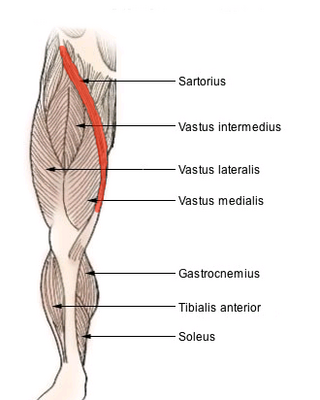
The sartorius muscle is the longest muscle in the human body. It is a long, thin, superficial muscle that runs down the length of the thigh in the anterior compartment.
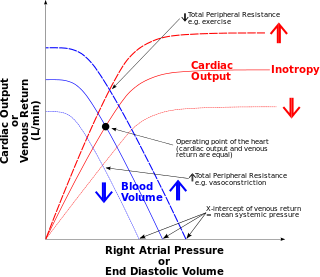
The Frank–Starling law of the heart represents the relationship between stroke volume and end diastolic volume. The law states that the stroke volume of the heart increases in response to an increase in the volume of blood in the ventricles, before contraction, when all other factors remain constant. As a larger volume of blood flows into the ventricle, the blood stretches cardiac muscle, leading to an increase in the force of contraction. The Frank-Starling mechanism allows the cardiac output to be synchronized with the venous return, arterial blood supply and humoral length, without depending upon external regulation to make alterations. The physiological importance of the mechanism lies mainly in maintaining left and right ventricular output equality.
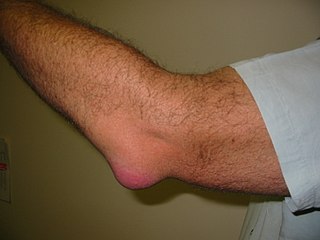
Bursitis is the inflammation of one or more bursae of synovial fluid in the body. They are lined with a synovial membrane that secretes a lubricating synovial fluid. There are more than 150 bursae in the human body. The bursae rest at the points where internal functionaries, such as muscles and tendons, slide across bone. Healthy bursae create a smooth, almost frictionless functional gliding surface making normal movement painless. When bursitis occurs, however, movement relying on the inflamed bursa becomes difficult and painful. Moreover, movement of tendons and muscles over the inflamed bursa aggravates its inflammation, perpetuating the problem. Muscle can also be stiffened.

Sarcoplasm is the cytoplasm of a muscle cell. It is comparable to the cytoplasm of other cells, but it contains unusually large amounts of glycogen (a polymer of glucose), myoglobin, a red-colored protein necessary for binding oxygen molecules that diffuse into muscle fibers, and mitochondria. The calcium ion concentration in sarcoplasma is also a special element of the muscle fiber; it is the means by which muscle contractions take place and are regulated. The sarcoplasm plays a critical role in muscle contraction as an increase in Ca2+ concentration in the sarcoplasm begins the process of filament sliding. The decrease in Ca2+ in the sarcoplasm subsequently ceases filament sliding. The sarcoplasm also aids in pH and ion balance within muscle cells.
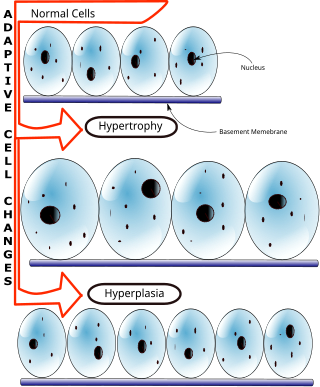
Hyperplasia, or hypergenesis, is an enlargement of an organ or tissue caused by an increase in the amount of organic tissue that results from cell proliferation. It may lead to the gross enlargement of an organ, and the term is sometimes confused with benign neoplasia or benign tumor.
Myofascial release is an alternative medicine therapy claimed to be useful for treating skeletal muscle immobility and pain by relaxing contracted muscles, improving blood and lymphatic circulation and stimulating the stretch reflex in muscles.
Permissive hypercapnia is hypercapnia in respiratory insufficient patients in which oxygenation has become so difficult that the optimal mode of mechanical ventilation is not capable of exchanging enough carbon dioxide. Carbon dioxide is a gaseous product of the body's metabolism and is normally expelled through the lungs.

Hypoxemia is an abnormally low level of oxygen in the blood. More specifically, it is oxygen deficiency in arterial blood. Hypoxemia has many causes, and often causes hypoxia as the blood is not supplying enough oxygen to the tissues of the body.
Counterstrain is a technique used in osteopathic medicine, osteopathy, physical therapy, massage therapy, and chiropractic to treat somatic dysfunction. It is a system of diagnosis and treatment that uses tender points, which are produced by trauma, inflammation, postural strain, or disease, to identify structures to manipulate. The manipulation uses light pressure to decompress the local nociceptors and mechanoreceptors responsible for the sensation of pain, returning central sensitization to its normal state. This technique extends Strain-counterstrain, a technique inhibits the reflexes by putting the tissues in a position of ease directly opposite to that of the reflex. Strain-counterstrain is also known as the Jones technique,, and spontaneous release by position. Counterstrain was developed by Lawrence Jones in 1955 and was originally called “Spontaneous Release by Positioning,” before being termed “strain-counterstrain.”
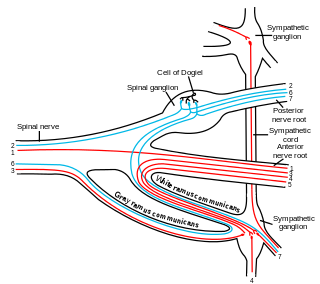
The general visceral afferent (GVA) fibers conduct sensory impulses from the internal organs, glands, and blood vessels to the central nervous system. They are considered to be part of the visceral nervous system, which is closely related to the autonomic nervous system, but 'visceral nervous system' and 'autonomic nervous system' are not direct synonyms and care should be taken when using these terms. Unlike the efferent fibers of the autonomic nervous system, the afferent fibers are not classified as either sympathetic or parasympathetic.
The core or trunk is the axial (central) part of an organism's body. In common parlance, the term is broadly considered to be synonymous with the torso, but academically it also includes the head and neck. Functional movements are highly dependent on this part of the body, and lack of core muscular development can result in a predisposition to injury. The major muscles of the core reside in the area of the belly and the mid and lower back, and peripherally include the hips, the shoulders and the neck.

Oguchi disease is an autosomal recessive form of congenital stationary night blindness associated with fundus discoloration and abnormally slow dark adaptation.

Bed rest, also referred to as the rest-cure, is a medical treatment in which a person lies in bed for most of the time to try to cure an illness. Bed rest refers to voluntarily lying in bed as a treatment and not being confined to bed because of a health impairment which physically prevents leaving bed. The practice is still used although a 1999 systematic review found no benefits for any of the 17 conditions studied and no proven benefit for any conditions at all, beyond that imposed by symptoms.
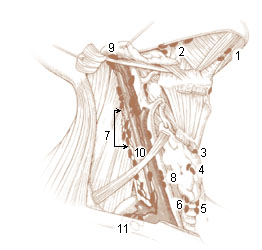
The jugulodigastric lymph nodes are large lymph nodes of the neck.
Myopathic gait is a form of gait abnormality.
An adjustable bed is a bed which has a multi-hinged lying surface which can be profiled to a number of different positions. Common adjustments include inclining the upper body and raising the lower body independently of each other. Other common features include height adjustment and tilting the bed to raise the upper body or the lower body into the Trendelenburg or reverse Trendelenburg positions.
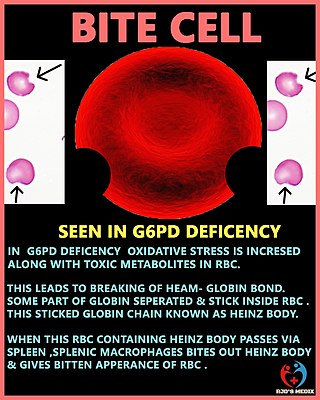
A degmacyte or bite cell is an abnormally shaped mature red blood cell with one or more semicircular portions removed from the cell margin, known as "bites". These "bites" result from the mechanical removal of denatured hemoglobin during splenic filtration as red cells attempt to migrate through endothelial slits from splenic cords into the splenic sinuses. Bite cells are known to be a result from processes of oxidative hemolysis, such as Glucose-6-phosphate dehydrogenase deficiency, in which uncontrolled oxidative stress causes hemoglobin to denature and form Heinz bodies. Bite cells can contain more than one "bite." The "bites" in degmacytes are smaller than the missing red blood cell fragments seen in schistocytes.
An antigonadotropin is a drug which suppresses the activity and/or downstream effects of one or both of the gonadotropins, follicle-stimulating hormone (FSH) and luteinizing hormone (LH). This results in an inhibition of the hypothalamic-pituitary-gonadal (HPG) axis, and thus a decrease in the levels of the androgen, estrogen, and progestogen sex steroids in the body. Antigonadotropins also inhibit ovulation in women and spermatogenesis in men. They are used for a variety of purposes, including for the hormonal birth control, treatment of hormonally-sensitive cancers, to delay precocious puberty and puberty in transgender youth, as a form of chemical castration to reduce the sex drives of individuals with hypersexuality or pedophilia, and to treat estrogen-associated conditions in women such as menorrhagia and endometriosis, among others. High-dose antigonadotropin therapy has been referred to as medical castration.

Locomotion in space includes all actions or methods used to move one's body in microgravity conditions through the outer space environment. Locomotion in these conditions is different from locomotion in a gravitational field. There are many factors that contribute to these differences, and they are crucial when researching long-term survival of humans in space.
References
- ↑ McGraw-Hill Encyclopedia of Science and Technology
- ↑ Lenz, Thomas L. (2007). Lifestyle Modifications in Pharmacotherapy. Baltimore: Lippincott Williams & Wilkins. p. 298. ISBN 978-0-7817-7651-6.
- ↑ Woods, Susan L.; Erika Sivarajan Froelicher; Sandra Adams Motzer (2004). Cardiac Nursing. Philadelphia: Lippincott Williams & Wilkins. p. 921. ISBN 0-7817-4718-X . Retrieved 2013-04-07.